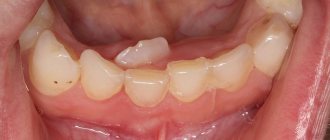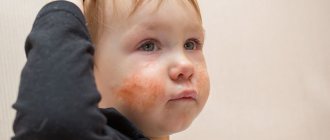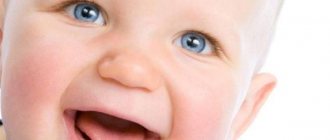Why a child has no teeth: the most common reasons
- Sometimes the reason lies in nutrition. Breastfed babies' teeth come out a little later than bottle-fed babies' teeth.
- Sometimes the delay is associated with a previous illness, intestinal dysfunction, improper metabolism or vitamin D deficiency.
- In some cases, late eruption is the result of pathologies during the mother's pregnancy. In this case, the sequence may be disrupted, and sometimes the rudiments of teeth are completely absent.
- If the tooth is initially located in the gum not vertically, but horizontally, which also occurs, it will erupt after 10-11 months.
- It is extremely rare that there are no teeth due to congenital adentia (genetic predisposition).
The child's baby teeth are not growing. This is fine?
Many parents worry about when their children will finally get baby teeth. What to do if the baby’s first tooth has not yet come out at six months? What if, at two years old, the child’s mouth still does not have a full set of teeth? Is the order in which teeth appear important or can everything happen individually?
Yulia Selyutina
Pediatric dentist
We decided to ask all these questions to the pediatric dentist and founder of the Dentistry Center Yulia Selyutina (@stomatolog_selyutina) to finally calm parental concerns.
From birth to three years of age, the child—and along with the parents—goes through several stages of development, as a result of which a full set of baby teeth appears in his initially toothless mouth.
There are diagrams and tables that show the timing of the eruption of baby teeth. It is these numbers that doctors and parents often rely on when waiting for the next tooth to appear.
On average, baby teeth begin to erupt at six months, and the last ones appear by two and a half years.
However, it should be remembered that all these terms are relative and highly averaged. Deviations can be either smaller or larger. Sometimes there is a direct dependence on the climate in which the child lives, nutrition, genetic and individual developmental characteristics.
Don’t worry if your baby doesn’t have a single tooth at one year old or if one or more teeth have already erupted at three months. By the way, teeth can come out one at a time or in pairs and even in groups. This is also normal. Even if the first baby tooth erupts closer to a year, there is no reason to worry.
So, if the pediatrician says that everything is in order with the child’s general health, then we put panic aside, allowing the baby’s teeth to appear at the right time for them. Teeth cutting out of order or at the wrong time is not a reason to prescribe medications or vitamins.
Moreover, a dentist has no right to do this. Calcium and vitamins are prescribed only by a pediatrician if there are compelling reasons for this.
Around 2.5–3 years of age, the child has all his milk teeth, that is, 20 teeth. If not all teeth have erupted by this time, then you can worry and urgently make an appointment for a professional examination with a pediatric dentist.
Read more on the topic
The longest baby tooth is included in the Guinness Book of Records
The child does not want to brush his teeth: here are 6 applications that will correct the situation
3 Serious Dental Problems That Children Have (and That Can Be Prevented!)
Who are we and where can you read us?
After all, we have not only a website!
How a dentist can help
If you are not ready to wait a year, seek help from a good pediatric dentist. The specialist will take an X-ray of the jaw to ensure the presence of tooth buds. If everything is fine, all you have to do is calmly wait for the process to begin - gum enlargement and increased salivation. Now it's time to help the baby:
- a ring stimulator will moderate itching, reduce discomfort and speed up teething;
- You can gently massage your child’s gums with a clean finger or a small spoon;
- stimulates tooth growth and fortified complementary foods - healthy juices and purees. While there are no teeth, solid complementary foods cannot be introduced.
Facts about teething
Teething is a complex physiological process that lasts for several years. During this period, the formation of tooth germs and their movement inside the jaw occurs. The process of teething is most often quite painful. There is a gradual change in the bite: a temporary (milk bite) changes to a permanent one. This is due to the development of bones in the child, in particular, with the growth of the skull bones. Also during this period, the formation of bone structures, soft tissues that surround the tooth, and the resorption of the roots of the milk units occurs to free up space for the permanent ones.
The first stage of tooth formation begins in the embryonic period. The complete completion of this process occurs with the eruption of wisdom teeth at approximately 25 years of age.
Parents' actions
Why did a newborn baby vomit blood during feeding - reasons
Parents should be wary only if their baby is completely missing teeth by the age of one. If there are simply few of them, then these are the individual characteristics of the child.
After a consultation with a pediatrician, tests can be performed and, if necessary, an x-ray of the baby’s jaw to determine the reasons for the delay in teething. If there are no abnormal processes or congenital pathologies, then you just need to wait.
In some cases, your doctor may recommend taking vitamin D. However, parents should not decide on their own how to take it.
Teething in most cases is accompanied by general and local symptoms, which can be more or less irritating for the baby. Overall, these are minor and temporary disruptions. The most common are:
- swollen and inflamed gums;
- excessive salivation;
- excitability;
- disturbed sleep;
- in some cases, lack of appetite, fever, diarrhea.
At 7 months of age, it is still too early to worry and you should not take any action to speed up teething. However, you can help your baby ease this process if his teeth are about to come out:
For your information. All activities must be done in compliance with the necessary hygiene.
- When a child puts everything that comes into his hands into his mouth, it is necessary to prepare a special children's toy or rubber rings. They massage the gums and stimulate teeth to come out. In addition to toys, you can give your baby pieces of fruit or vegetables, but they should be large enough to prevent part of the fruit from getting into the throat;
Baby with teething ring
- Cold eases the itching and pain of teething, so before giving it to your baby, you can put the toy or rings in the refrigerator (but not in the freezer!);
- You can massage your gums with your hands, placing sterile gauze soaked in cold water on them;
- Anti-inflammatory and analgesic teas (sage, chamomile) are very effective in combating gum pain. They are sold at the pharmacy. You need to give your child tea from a spoon; you can apply it to the gums with a cotton swab;
- If your baby is drooling a lot, it is best to wear a bib during the day. The skin around the mouth must be kept dry, otherwise redness and irritation will appear.
Parents must be patient and remember that each child is different. For him, there are only his own timing and order of teething, which may differ even from the timing of his siblings. Not all children cut their teeth according to average patterns, just as not all of them suffer when the first tooth comes out.
When should you see a doctor?
Teething causes a lot of discomfort for the baby. This does not require medical attention. But there are situations when you cannot do without the help of a doctor. You should contact him in the following cases:
- Painful cough.
- The temperature does not subside for a long time.
- There is mucus and blood in the stool.
- Diarrhea
- and purulent nasal discharge.
- Constipation.
- Mouth ulcers.
- Unnatural color of the shoots.
Symptoms from teething hide the manifestation of diseases, for example, ARVI or infectious diseases. It is important to consult a doctor if negative symptoms occur. Exercise caution in such cases rather than regret later what you didn’t do.
Features of teething
Teething can be painless, without disturbing the baby’s well-being or changing his behavior. However, in most cases, this process is accompanied by hyperemia, fever, refusal to eat and many other symptoms.
At this stage of child development, all dads, and especially moms, need to be patient and prepare themselves for the fact that the period of teething may be accompanied by severe symptoms.
Modern parents are very worried about this problem, so they try to carefully read the necessary literature, learn from the experience of relatives, in order to prepare for the appearance of the first incisor. More often, mothers find plans that provide the required number of teeth at a given period of age, and if there are no expected results within the specified period, they begin to panic.
Is it possible to know in advance which tooth will make itself known first? In what order do children's teeth appear? It is quite difficult to answer questions with accuracy, since each organism is special and its development occurs in its own way.
Prevention of pathologies of eruption of baby teeth in children
It is impossible to control or influence such processes.
Dental buds are formed even before the baby is born, so after his birth it is difficult to change anything. During pregnancy, a woman should monitor her health, in case of illness, immediately consult a doctor, not self-medicate and not advance the disease. It is important to take vitamins, as they have a beneficial effect on the condition of the expectant mother and child.
After birth, parents are obliged to monitor the baby’s condition - take care of his health, provide complete and proper nutrition. This will affect not only the condition of the teeth, but also the overall development of the child.
Types of delay in teething
A discrepancy from the average statistical time of more than six months in the eruption of baby teeth is considered a delay.
The delay from the average time in the appearance of permanent teeth should not exceed a year. There are two types of late eruption.
- Late formation of dental follicle. In such a situation, the relationship between the development of the tooth and its appearance in the oral cavity is observed, but both processes proceed more slowly than expected.
- Late eruption. With this development, the tooth is fully formed, its root grows, but the dental unit cannot erupt. Fully formed teeth remain in the bone – impacted. They may be completely under the gum or partially visible from under it.
Before worrying about delayed eruption, it is necessary to diagnose the presence of a tooth germ in the bone. To do this, a panoramic photograph is taken, which makes it possible to distinguish the complete absence of a rudiment from a delay in formation.
How many teeth should a child have at 14 years old?
- Teenagers of this age have already lost their baby teeth, but their permanent teeth are about to grow in. In total, there should be 28 of them available.
- Sometimes the growth process drags on for up to 15 years. But wisdom teeth never grow back. At the age of 14, unfortunately, 28% of adolescents have dental anomalies.
- Either they grow crookedly and sideways, or they protrude from the general row of teeth. You cannot cope with such problems on your own. Please note that already at this age the correct taste is formed.
- To solve the problem, visit an orthodontist. The sooner you go to him, the easier it will be to resolve this unpleasant situation.
How many teeth should a child have at 1.5 - 2 years old?
Having reached 1.5 years of age, a child may have only 4 teeth, although according to the above formula he should have 13-14 teeth. It’s okay - this is considered the norm; in such cases, dentists advise giving the baby hard cheese to chew to stimulate their growth.
Already at this age, your baby should be taught to take care of the oral cavity. Use your example to show how you brush your teeth. Give your child a toothbrush and let him repeat the movements after you, only without the toothpaste.
Schedule glitches: reasons
When a baby has no teeth at 8 months, this cannot be attributed to pathology. The period of appearance of teeth in a child is associated with the characteristics of the body. It happens that a baby may be born with teeth.
Circumstances for which there are no teeth at 8 months:
- Genetic factor.
- Lack of calcium and vitamin D.
- Metabolic disorders in the mother and inflammation in the body during pregnancy.
- Drinking alcohol, smoking during pregnancy.
Diagram of teeth in a 3 year old child
Let us now summarize when and in what order the upper and lower primary teeth appear.
- The lower two central incisors appear at 6-10 months of age
- The upper two incisors usually grow in 8-12 months
- The upper two lateral incisors will appear at 9-13 months
- The two lateral incisors from below grow in 10-16 months
- The two upper molars will grow in at 13-19 months
- Two lower molars will appear at 14-18 months
- The upper canines usually grow in between 16 and 22 months.
- The lower two canines will erupt in 17-23 months
- The lower two second molars grow in at 23-31 months
- The upper two second molars grow at 25-33 months
Thus, by the age of three, the baby should already have 20 milk teeth.
How many teeth should a child have per year?
According to the formula for calculating the number of teeth, at 12-13 months the baby should already have 8 teeth. 4 on top, 4 on bottom. The formula looks like this:
Ν = Κ - 4, where Ν is the number of teeth; Κ is the baby’s age in months, and 4 is a constant value .
IMPORTANT: This is the year you will need to go to the dentist with your daughter or son for the first time, even if the child has no reason to worry about the health of the mouth and teeth.
When does a child cut his first tooth?
According to pediatricians, the timing of teething is individual for each baby. In some children they appear at 2-3 months, while in others at 9 months or a year. Oddly enough, this phenomenon is considered the norm. The main thing is that by the time your daughter or son reaches the age of three, she already has 20 baby teeth in her mouth.
Every mother should prepare both mentally and physically for such a responsible task.
- You will have to be patient with your child's whims. Surround your child with affection, care, love.
- Do daily cleaning, keep toys clean, and also maintain your and your child’s hygiene. After all, babies during such a period often put everything in their mouths; your task is to prevent the child from catching an intestinal infection.
- To make teething easier, you can buy special teethers (gum massagers). They have an anti-pain effect.
- Special gels are good for gum pain relief. Just don’t think that they help teething. They only relieve inflammation, relieve some pain and soothe irritated gums.
- If a child's temperature rises above 38, then visit a pediatrician. The cause of elevated temperature can be not only teething, but also various diseases.
IMPORTANT: Before using gels to soothe gums during tooth growth, consult with your pediatrician which drug is best to use.
How many teeth should a child have at 6-8 years old?
Already at the age of 6 years, future schoolchildren begin to lose milk teeth and grow permanent ones instead. This process lasts several years, gradually. First, the lower front incisors change, the permanent ones appear instead, then the upper ones. It is during these two years that the 4 front incisors will change.
IMPORTANT: Teeth need care, to avoid the well-known caries, buy your child toothpaste with fluoride, let him brush his teeth 2 times a day.
How many teeth should a child have at 6-7 months?
During this period, the child sometimes develops lower and upper central incisors - 2-4 teeth. Signs of the appearance of incisors, however, like other baby teeth, can be:
- cough, runny nose
- elevated temperature
- swelling of the gums
- diarrhea, vomiting, constipation
- drowsiness, tearfulness
- diathesis
However, all these symptoms disappear after 2-7 days, when the gum inflammation subsides.
What Doctor Komarovsky says
Experienced doctor Komarovsky in his lessons gives answers to the problems that will arise for parents if the baby’s teeth do not appear. You can find many videos with his lessons on the Internet.
The main reasons for missing teeth on time are a lack of calcium and vitamin D. Much depends on the individual characteristics of the child and his body. Without examining the baby, it is impossible to say with certainty why he has a pathology.
In case of such a problem, it is important to visit a pediatrician, who will examine, find out the cause of the disorders, and refer you for consultations with doctors, if necessary.
How many teeth should a child have at 2.5 years old?
At 2.5 years old it is considered normal if your child already has 20 teeth. Moreover, these baby teeth last up to 5-6 years. There are various atypical situations; if they arise, you need to visit an orthodontist or dentist.
- Very early appearance of teeth sometimes indicates the presence of pathologies in the endocrine system.
- Late growth of teeth is caused by genetic factors, diseases of infectious origin, the presence of rickets, and disruption of the gastrointestinal tract.
- Incorrect position of the incisor, unusual, damaged appearance of the tooth indicates violations of the bone component, incorrect location of the axis of the incisor.










